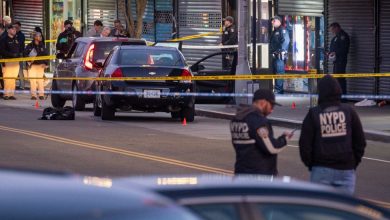Your Friday Briefing: Biden Calls Death of ISIS Leader a Warning

We’re covering the pre-dawn raid to kill an ISIS leader, and Russia’s response to the U.S. troop deployment.

The aftermath of a U.S. raid in which the leader of the Islamic State, Abu Ibrahim al-Hashimi al-Qurayshi, died in Idlib, Syria, on Thursday.Credit…Yahya Nemah/EPA, via Shutterstock
Biden calls ISIS leader death a warning to terrorists
President Biden said on Thursday that the leader of the Islamic State died during a raid by U.S. Special Operations commandos in a predawn attack in northwest Syria.
About two dozen American commandos carried out a helicopter-borne assault targeting Abu Ibrahim al-Hashimi al-Qurayshi, which began around midnight at a residential building in Atmeh, in Syria’s Idlib Province. Rescue workers said women and children were among at least 13 people killed during the raid.
Biden said al-Qurayshi died when he exploded a bomb that killed him and members of his family. Biden added in a statement, “All Americans have returned safely from the operation.”
Details: Two senior officials gave an initial account of the raid. Witnesses described the scene outside to The Times; photographs captured the aftermath.
Al-Qurayshi: Little is known about the ISIS leader, who was 45 and born in Iraq. He lived off the grid, and left the building in Atmeh only occasionally to bathe on the roof.
Context: The raid came days after a battle over a Syrian prison where ISIS fighters were held, the largest U.S. combat involvement with the Islamic State since the end of the caliphate three years ago.
Russia denounces U.S. deployment
The Kremlin said on Thursday that the U.S. plan to send troops to Eastern Europe over concerns about Ukraine was intended to “stir up tensions.”
The U.S. had announced the decision to send the 3,000 additional troops on Wednesday, saying that doing so would help defend NATO allies from the threat of Russian aggression.
U.S. officials and satellite imagery indicated that Russia had not slowed its military buildup, adding more troops and military hardware over the past 24 hours near the Ukrainian border and in neighboring Belarus.
But the Kremlin spokesman, Dmitri Peskov, accused the Americans of “igniting tensions on the European continent,” and described the U.S. deployment to Poland and Romania as a threatening act “in the vicinity of our borders.”
Response: “These are not permanent moves — they are precisely in response to the current security environment in light of this increasing threatening behavior by the Russian Federation,” said Ned Price, the U.S. State Department spokesman. Price emphasized that the country would not send troops into Ukraine.
Related: American officials on Thursday accused Moscow of plotting to fabricate a camera-ready “attack” on Russian interests, and said that the plot was far enough along that corpses for the footage had already been found.
Australia and New Zealand are reopening. Are residents ready?
Australia, the government says, is ready to “live with the virus” after nearly 95 percent of adults there have been vaccinated. But many people don’t feel ready.
When the state of South Australia announced it was ending intensive contact tracing, a Facebook group formed so residents could do their own. The prime minister declared lockdowns a thing of the past, but then so many residents of Australia’s two biggest cities stayed inside during an Omicron spike that it was labeled a “shadow lockdown.” Even as borders opened for the first time since March 2020, the nation mostly stayed put.
The country has gone through a dizzying U-turn in its pandemic approach. For 18 months, it tried to snuff out every outbreak. Then, late last year, the government declared Australia would “stare down” Omicron and “not go back.” This week, though, Prime Minister Scott Morrison conceded that the authorities had raised expectations for a rebirth too high.
Asia-Pacific nations are not eager to emulate what Australia has done, with Japan, South Korea and Thailand pausing or rolling back reopenings. New Zealand is taking a more cautious approach, gradually reopening to travelers from abroad over the next nine months.
The numbers: The Omicron tide peaked at 150,000 new daily cases on Jan. 13. Before this wave, the country had never reached 3,000 cases in a day. And last Friday, Australia had its deadliest day of the pandemic, reporting 98 deaths.
Here are the latest updates and maps of the pandemic.
In other developments:
-
Several athletes and at least one International Olympic Committee member will not take part in the Games after testing positive for the coronavirus.
-
For the past year, scientists have been looking for the source of strange coronavirus sequences that have appeared in New York City’s wastewater.
THE LATEST NEWS
Asia Pacific
-
An Olympic rule and warnings from the Chinese government have made it risky for athletes to speak out at the Winter Games.
-
Thomas Bach, the president of the International Olympic Committee, said Thursday that he would meet at the Winter Olympics with the tennis player Peng Shuai. He added that he would not push for an investigation of her assault allegations unless she asked for one.
-
Malaysians obsessed with thrift shopping have found a global market for high-end secondhand clothing.
Around the World
-
More than 100 million Americans were under weather warnings on Thursday after a snowstorm caused closures and crashes from New Mexico to Indiana and beyond.
-
As Russia squeezes natural gas supplies, a parade of tankers carrying liquefied natural gas is coming to Europe’s rescue.
-
Meta, formerly Facebook, said its virtual reality division had lost more than $10 billion last year.
A Morning Read
Credit…David Bulmer
Tanya Muzinda got her first motocross bike when she was 5, breaking her family tradition of passing down bikes to the firstborn boy of each generation. Now, Muzinda, a 17-year-old high school junior from Zimbabwe, is competing on the global stage with the help of her mentor, Stefy Bau, a three-time world champion.
ARTS AND IDEAS
Queen Elizabeth’s platinum jubilee
Seventy years ago this Sunday, a front-page story in The Times marked the end of one age and the start of another: The 25-year-old Princess Elizabeth became queen on Feb. 6, 1952, after her father, King George VI, died in his sleep at 56. “For the first time in 115 years, a woman ascended the world’s most exalted and stable throne,” The Times reported.
At 95, Elizabeth is the world’s longest-reigning monarch and the only British monarch ever to celebrate a platinum jubilee. Her seventy-year reign has encompassed profound changes, including the shrinking of the country’s empire, with many historians seeing the Hong Kong handover in 1997 as its final step.
Throughout it all, Elizabeth has never relinquished the formality and pageantry of the role. Yet the actions of her descendants have ushered the Royal Family into a new chapter, often characterized by more time in the spotlight — and a sometimes difficult relationship with the media.
Many will remember the image of the queen grieving alone last year at a physically distanced funeral for Prince Philip, her husband of 73 years. But in her Christmas speech, Elizabeth expressed a hope that her Platinum Jubilee would “be an opportunity for people everywhere to enjoy a sense of togetherness.” Celebrations are planned all over the world.
PLAY, WATCH, EAT
What to Cook
Cauliflower isn’t boring in this cashew coconut curry.
What to Watch
The documentary “Breaking Bread” follows the preparations for a food festival at which chefs from Arab and Jewish backgrounds team up to create dishes together.
What to Read
“The Books of Jacob,” the new novel by Nobel Prize-winning Polish novelist Olga Tokarczuk, affirms life while exploring the nihilistic disregard for its unglamorous fundamentals.
Now Time to Play
Here’s today’s Mini Crossword, and a clue: “Opposable” body part (five letters).
And here is today’s Spelling Bee.
You can find all our puzzles here.
That’s it for today’s briefing. See you next time. — Melina
P.S. Francesca Barber is our International desk’s new director of operations and strategy.
The latest episode of “The Daily” is about ISIS.
Natasha Frost wrote the Arts and Ideas section. You can reach Melina and the team at [email protected].





